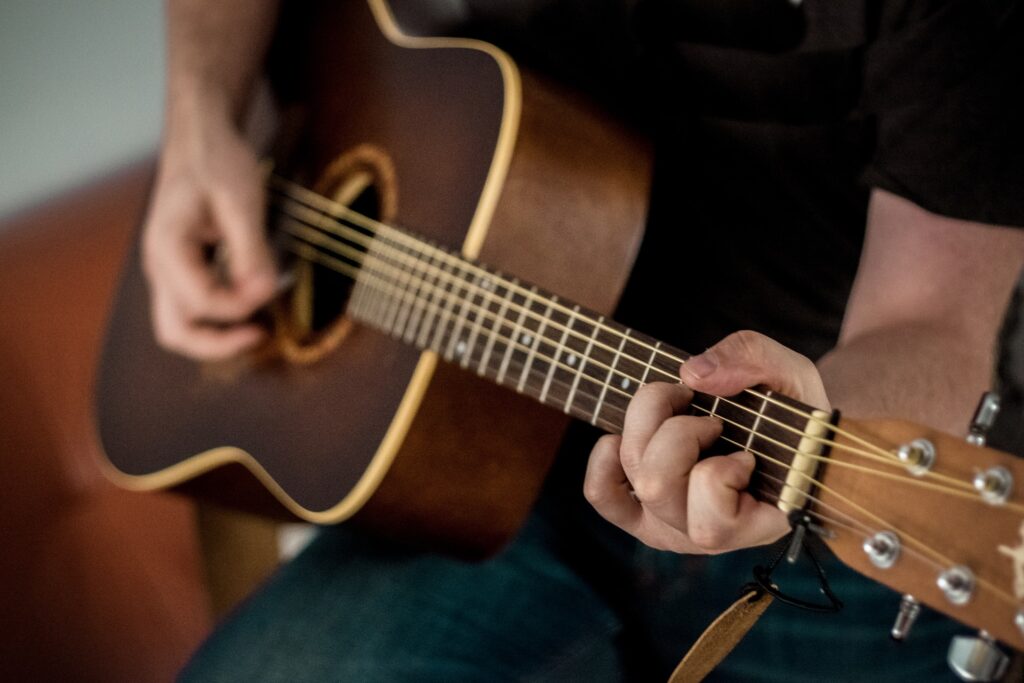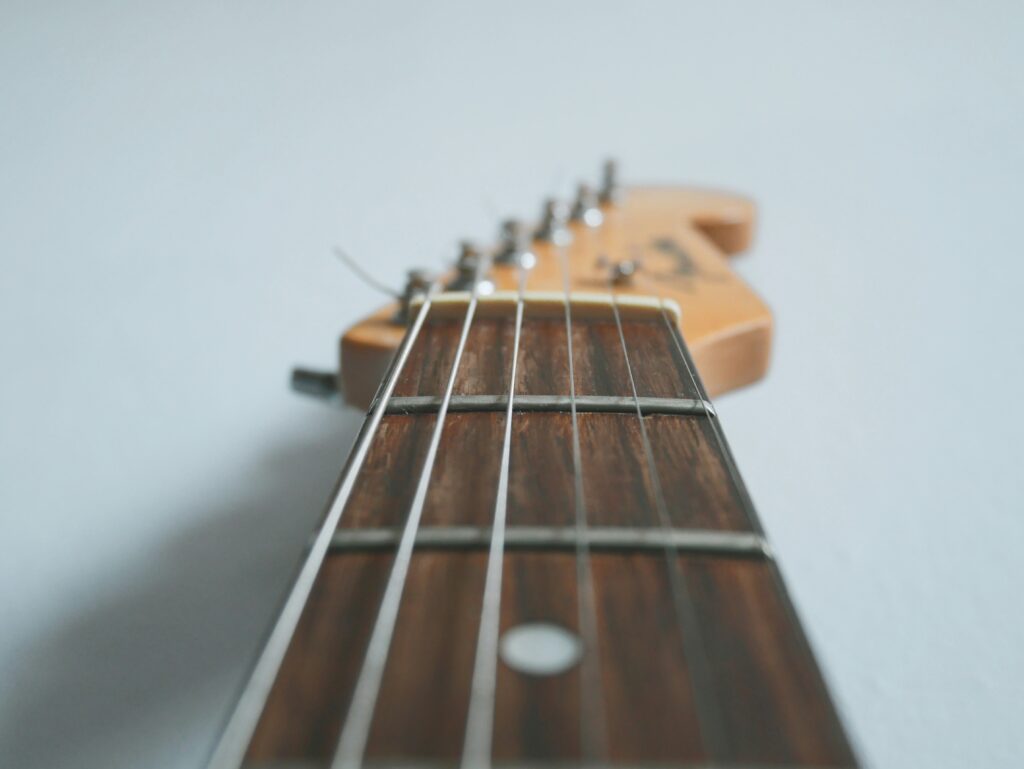
*contains sponsored content
It feels incredible when a guitar is tuned correctly, and all of the strings resound in perfect harmony. A guitar, however, is a delicate and complex instrument. However, while playing an acoustic guitar, there might be moments when the sound can get a little off, like the rattling of a string or more against the frets while you play, which is a fret buzz.

The buzzing sound produced by a single or more guitar string is known as fret buzz or string buzz. From the bridge to the nut, the fretted note must be the sole point of contact between a string and the fretboard. String vibrations can also be felt on other parts of the acoustic guitar, typically another fret near the saddle, and this secondary contact results in a metallic rattling sound. Although it has nothing to do with fret buzz, loose hardware can also cause rattling. Before inspecting the strings, ensure no loose strap pins, pegheads, or turning posts if the buzzing persists.
Fret buzz is something most guitarists will face quite regularly in their careers. Fortunately, determining the origin of this annoying issue and fixing it isn’t too tricky. You’ll need to assess your playing technique first. If your strings are buzzing all over the neck, it could be because you aren’t firmly pressing down on the strings or your finger is too far behind the fret. On the other hand, it can be an issue with the instrument and your playing style. In that case, you or an experienced guitar technician can fix the buzz of your guitar.
Today, we will talk about how different fret buzzes can occur and how you can fix them.
Let’s figure out some of the basic reasons you are having fret buzz and how you can solve them.

First, check your playing technique if you only hear a buzz when fretting a chord or a note, not on open strings. An uneven, buzzy tone or notes that fade away soon can occur due to not pressing down on the strings hard enough. Buzzing can also be caused by pressing too far down from the fret you intended to press. Also, pushing your fingers between two frets will cause a rattling sound. It may be your picking hand as well. Overly forceful strumming can cause the strings to vibrate erratically, leading to a fretting buzz.
The good thing is you won’t need to fix the instrument in this case. Practice pressing down evenly and firmly with your fretting hand to deal with the issue. Keep your thumb perpendicular to the strings and positioned precisely behind your fingers, around halfway up the neck. Also, get your fingertips as near the frets as you can. Finally, strum with confidence, not aggression.
If the fret buzz persists after several practice sessions, you should look elsewhere to identify the issue.
If the frets have accumulated a heavy layer of filth, all six strings may buzz against them. Occasionally, you could hear the buzzing of just one guitar string, which could indicate unwinding or kinking. Stop playing and check each string individually if you hear buzzing. Keep an eye out for accumulation, rust, or unravelling.
Put a set of new strings on your guitar if the strings are dirty or noisy. You can replace just the buzzing string if your strings are unique and come from just one of them. You can avoid ruining a brand-new set by purchasing separate strings from music retailers. Your playing habits will determine how often you should rest your guitar. Whatever the case, getting a new set of strings may be necessary when you notice any damage or buzzing, regardless of how long it has been since you last changed them. Also, wipe the strings off with a dry towel following every session to extend their life.
There are two ways in which an acoustic guitar’s strings can buzz when the acoustic guitar is dry:
A shrinking fingerboard, where the frets’ edges protrude from the fretboard, is another sign that the guitar has dried out. Living in a region with consistently low relative humidity means you could have to deal with this issue all year round. Nevertheless, guitars typically become dry during the winter months due to artificial heating.
Relative humidity levels between 45 and 55 per cent are ideal for protecting your guitar from drying out. The Humidipak and a digital hygro-thermometer can help you do so. Try keeping your guitar in its case with these tools if you can’t ensure the required RH within a room. Your guitar might need to adjust its truss rod once its humidity levels return to normal.

Problems with the neck tension of your guitar could cause your fret to create a buzzing sound if you have recently adjusted your guitar’s string gauges or tunings or if the guitar dried out. The neck of a guitar should have a slight bow to the forward. To allow the strings to vibrate freely, there should be space. The strings will clatter against the frets when the neck is perfectly back bowed or flat. However, applying pressure on the strings will require much more effort if the neck is bent too much.
Adjusting the truss rod is the way to go if you want to make the neck bow more or less. The truss rod is a metal bar that goes inside a guitar’s neck. You can adjust the neck’s angle by loosening or tightening it with a 1/4-inch nut driver. Your guitar’s truss rod may be accessible via the soundhole at the base of the neck or beneath a cover on the headstock, depending on the manufacturer. Consult a guitar technician if you need clarification about adjusting the truss rod.
As time passes, you might notice that some frets are loose, protruding, or sinking into the fretboard. Grooves can also develop at the point where the string and fret meet. When any of these occur, the notes might start to sound buzzy. An uneven fret might be the main issue if the buzzing is note-specific.
Fret dressing, which may include glueing down the unsteady frets, filing down elevated ones, or even changing some or many of the frets, is a standard procedure for fixing uneven frets. So, it is recommended that a professional handle it.
As the nut wears down from repeated use, the strings will sit lower and make more buzzing noises as they touch the frets. Typically, only older guitars face this issue. Check the nut’s groove width about the string’s gauge.
The standard procedure is to change out a worn-out, rusted nut. The best option is to take the guitar to a guitar technician.
The term “action” is defined by the gap between the fretboard and the strings. If the action is deficient, the strings will buzz when they rub across the frets. If you hear the string rattling even when the neck is in the correct position, it might be necessary to raise the action.
Fixing low action can sometimes be as simple as adjusting the truss rod. To remove the strings from the neck, loosen them by turning the truss rod counterclockwise. The middle frets, however, will show the most change compared to higher and lower frets. You should also raise the saddle to fix it. It will involve placing a shim under the current saddle or changing it. You must angle the saddle’s side lower or higher than the other side if only the bottom or top strings are buzzing. However, you’ll require guidance from a technician in both cases.
Fret buzz makes the guitar tune sound far from perfect. The sound is annoying and can translate to live performances or even recordings. But the good thing is that it is primarily fixable. The moment you notice the buzz, locate the origin of the issue. Ignoring it will worsen the problem if it’s a sign of anything more serious. The best approach to keeping your acoustic guitar in top condition, regarding both sound and looks, is to inspect it and perform any necessary repairs regularly.
Thanks for reading our article “How to Fix Fret Buzz on Acoustic Guitars?” We at Soundbrenner are dedicated to helping musicians stay focused on what truly matters: their music. By creating innovative devices, such as Soundbrenner Pulse and Core 2, our goal is to deliver the best practice experience for musicians. Click here to find out more.
Do you have a question about Soundbrenner products? Reach out to us at [email protected], we’re happy to help!